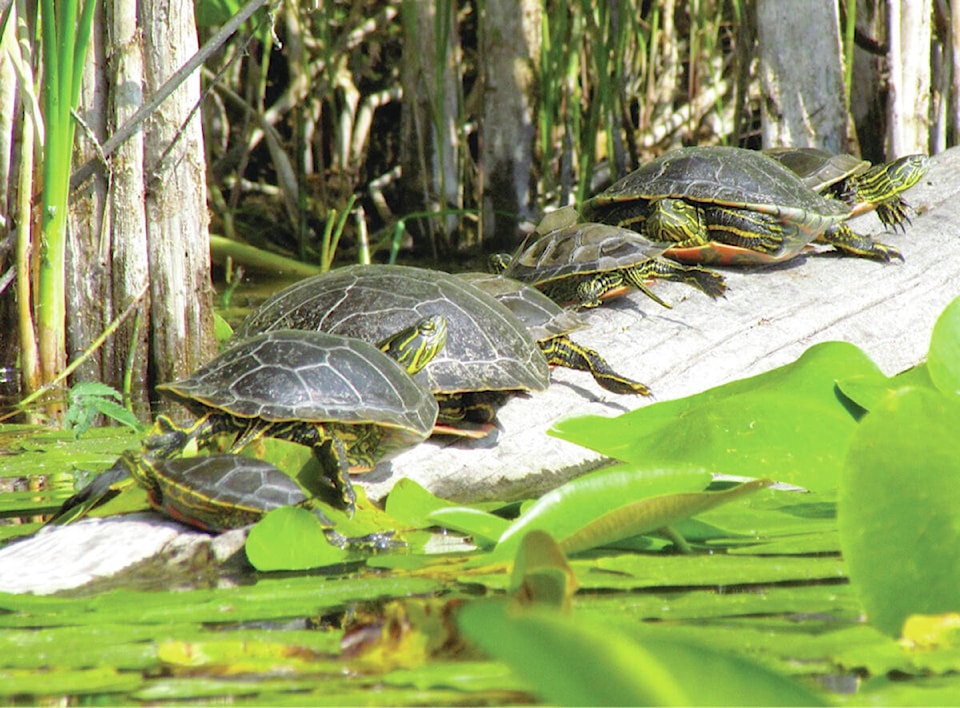Several local and regional ecosystem restoration projects are set to take place over next five years, with $1.8 million in funding support from Columbia Basin Trust (CBT).
Forests, wetlands and riparian areas are some of the habitats that will benefit from the projects, with a focus on ensuring healthy, diverse and functioning ecosystems in the Columbia Basin, CBT explained in a press release.
One such project in Cranbrook is aimed at reinvigorating the shoreline at Elizabeth Lake.
This restoration project is being headed up by the Rocky Mountain Naturalists over the next five years, with the goal of improving bird nesting habitat, providing anti-predator cover for young western painted turtles and minimizing invasive weeds and grasses. There will also be a basking habitat installed for the turtles, which birds will also use.
The City of Cranbrook says that there will be excavators working at the north end of the lake beginning in May.
“We will be planting native vegetation along the shoreline,” said the City.”Our goal is to improve plant cover, bird nesting opportunities, enhance carbon sequestration, and increase fire resistance. Native trees and shrubs will replace the weedy grasses, and fencing will keep deer from grazing on the newly planted vegetation.”
Marianne Nahm, President of the Rocky Mountain Naturalists, says that the project will improve foraging and nesting habitat for songbirds and shorebirds, while also benefiting a broader range of wildlife.
“Our project also aims to support the community of Cranbrook in accessing and connecting with nature and increasing opportunities to view, experience and learn about these fascinating species,” Nahm said.
In the Elk Valley, the Elk River Watershed Alliance will be undertaking a four-year project on 47 hectares along the Elk River, with the goal of planting around 20,000 cottonwood live-stakes and 8,000 native understory seedlings, CBT said.
The Alliance will also install animal-exclusion fencing to keep out animals like elk and cattle, allowing the young vegetation to grow.
“The goal is to improve the value of cottonwood habitat, connect floodplain cottonwood ecosystems and mitigate floods in the Elk Valley,” said Chad Hughes, Executive Director of the Alliance. “The project also aims to indirectly improve the functioning of aquatic ecosystems by creating shade to reduce stream temperature, reducing erosion and naturally introducing large woody debris to provide habitat for fish and aquatic wildlife, plus food and building materials for beavers.”
A five-year project along the Kootenay and Goat rivers will see the area return to a restored state to benefit wildlife and the ecosystem they call home there.
“Yaqan NuɁkiy has previous experience restoring wetlands, streams and floodplains, and will now use its expertise to restore 517 hectares of aquatic and terrestrial habitat along the Kootenay and Goat rivers,” said CBT. “Using 1926 aerial photographs as a guide, it will help the area more resemble its natural state through activities like filling ditches, adding culverts and controlling non-native plants. This will benefit species like northern leopard frog, white sturgeon and western painted turtle.”
This project builds on a wetland and stream restoration project that began back in 2018, explained Norman Allard Jr., community planner.
“In 2021, the Creston Valley experienced a severe drought where all wetlands, ponds and streams dried—except for the ones we had restored, which contained lush growths of native plants and supported large numbers of birds and other animals. This proved that the techniques we used were successful, and we’ll now use them on the current project,” Allard Jr. said.
Simpcw First Nation will also be working to restore wetlands in the Canoe Valley near Valemount. The project will see wetlands restored and built from scratch.
“Valley-bottom wetland and riparian areas serve numerous important ecological functions, including providing habitat for many fish and wildlife species, and targeted physical works can help restore these critical habitats and connectivity corridors,” said Caroline Feischl, Environmental Professional with Simpcw Resources Group, which is overseeing the project on behalf of Simpcw First Nation, in collaboration with LGL Limited. “This project will also engage members of the Simpcw First Nation, plus incorporate cultural and ecological knowledge, particularly by focusing on adding and locating plant species of cultural significance.”
VIDEO: B.C. couple says their water supply contaminated by logging activity
The British Columbia Conservation Foundation (BCCF) will also be working to enhance the Lake Ranch (Von Unruh) Conservation Property, which is owned by The Nature Trust of BC.
CBT says that over the next five years, BCCF will work on approximately 51 hectares of the land to plant trees, shrubs and flower meadows, while also adding wood structures for small animals and insects.
Last but not least, the region’s bats will benefit from a restored roosting habitat through a project with the Wildlife Conservation Society of Canada and other partners.
The four-year project will see three types of bat homes added to various places throughout the Basin.
“Bats fill an important function in ecosystems and provide direct benefits to local citizens through pest control services,” said Cori Lausen, Director of Bat Conservation. “Our goal is to encourage abundance and diversity of these nocturnal aerial insectivores by restoring roosting habitat in strategic areas. We will then monitor the effectiveness to learn which species select which types of roost creations and how well the bats do in these structures.”
corey.bullock@cranbrooktownsman.com
Like us on Facebook and follow us on Twitter
Want to support local journalism during the pandemic? Make a donation here.
